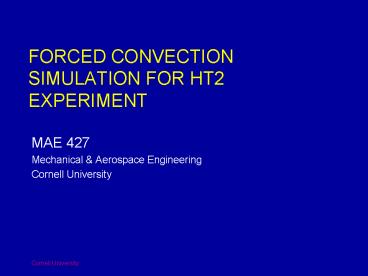FORCED CONVECTION SIMULATION FOR HT2 EXPERIMENT PowerPoint PPT Presentation
1 / 19
Title: FORCED CONVECTION SIMULATION FOR HT2 EXPERIMENT
1
FORCED CONVECTION SIMULATION FOR HT2 EXPERIMENT
- MAE 427
- Mechanical Aerospace Engineering
- Cornell University
2
Experiment vs. Modeling
- Modeling Well use FlowLab software
- FlowLab uses the computational modeling approach
to obtain an approximate solution to the
governing equations. Referred to as Computational
Fluid Dynamics (CFD). - Will use nominal data in simulation. You need to
redo with your data.
3
Strategy of CFD
- Eg. Continuous Domain p p(x), 0ltxlt1
Discrete Domain pi p(xi), i1,2,,N - Truncation error introduced. Can be reduced by
refining the grid. - Grid refinement study required to assess the
level of truncation error.
4
Geometry Step
- Assume flow is axisymmetric. Hence, domain is
rectangular. - Rotate the rectangle 360o about the axis to get
the full pipe geometry
5
Geometry Step
- Length of pipe included in the simulation From A
to D - Tip To restore original views, use the following
buttons at the bottom right of the GUI
6
Physics Step
- Incompressible ideal gas Neglect variations in
absolute pressure in ideal gas law - Properties use average values over temperature
range - Reynolds no. 100,000 Turbulent flow regime
7
Physics Step Turbulence
- Cannot resolve rapid fluctuations in turbulent
flow - We solve only for averaged quantities
- Need to augment governing equations with
turbulence model equations (additional
approximation!).
8
Physics Step Turbulence
- Will use k-e turbulence model.
- Workhorse in engineering calculations (but has
problems). - k turbulent kinetic energy Measure of the
kinetic energy of velocity fluctuations u, v
and w. - e turbulent dissipationMeasure of the
dissipation of k into internal energy. - See lab manual for more details.
9
Physics Step
- Operating condition
- Gauge pressure Absolute pressure Reference
pressure - Inlet boundary condition (BC)
- Assume velocity is constant across cross-section.
- Use guess values of k and e. Well specify low
turbulence levels. - Axis BC FlowLab imposes symmetry conditions.
10
Physics Step
- Outlet BC
- Outlet pressure needs to be specified. Use
measured gauge pressure at D. - Outlet velocity and temperature come out of the
simulation. - Wall BC
- FlowLab imposes no-slip condition for velocity.
- We specify the measured (constant) heat flux in
the heated section. - Well assume wall is smooth ((wall thickness
0). - Well neglect heat conduction within pipe wall
(wall thickness 0).
11
Solve Step
- Since governing equations are nonlinear,
iterations are required to solve the equations.
12
Post-Processing Step
- Temperature contours Is the flow well-mixed at
the end of the adiabatic mixing section?
13
Post-Processing Step
- Velocity vectors in the first section showing
flow development.
14
Reports Step
- Pressure variation along pipe axis. Yellow
symbols represent experimental values. - Can export these values in Excel format.
15
Reports Step
- Temperature variation along pipe axis. Yellow
symbols represent experimental values.
16
Reports Step
- Wall temperature variation. Shows thermal
entrance length effects.
17
Reports Step
- Nusselt number distribution.
- Can average values in the heated section to
compare with experiment. - Dont use friction factor values from FlowLab.
18
Reports Step
- Axial velocity profiles at various locations.
- Plot shows flow is nearly fully developed as it
enters the heated section. - Shows flow is accelerated in the heated section.
19
Reports Step
- Temperature profiles at various locations.
- Plot shows temperature is nearly uniform at the
outlet (end of the mixing section).

